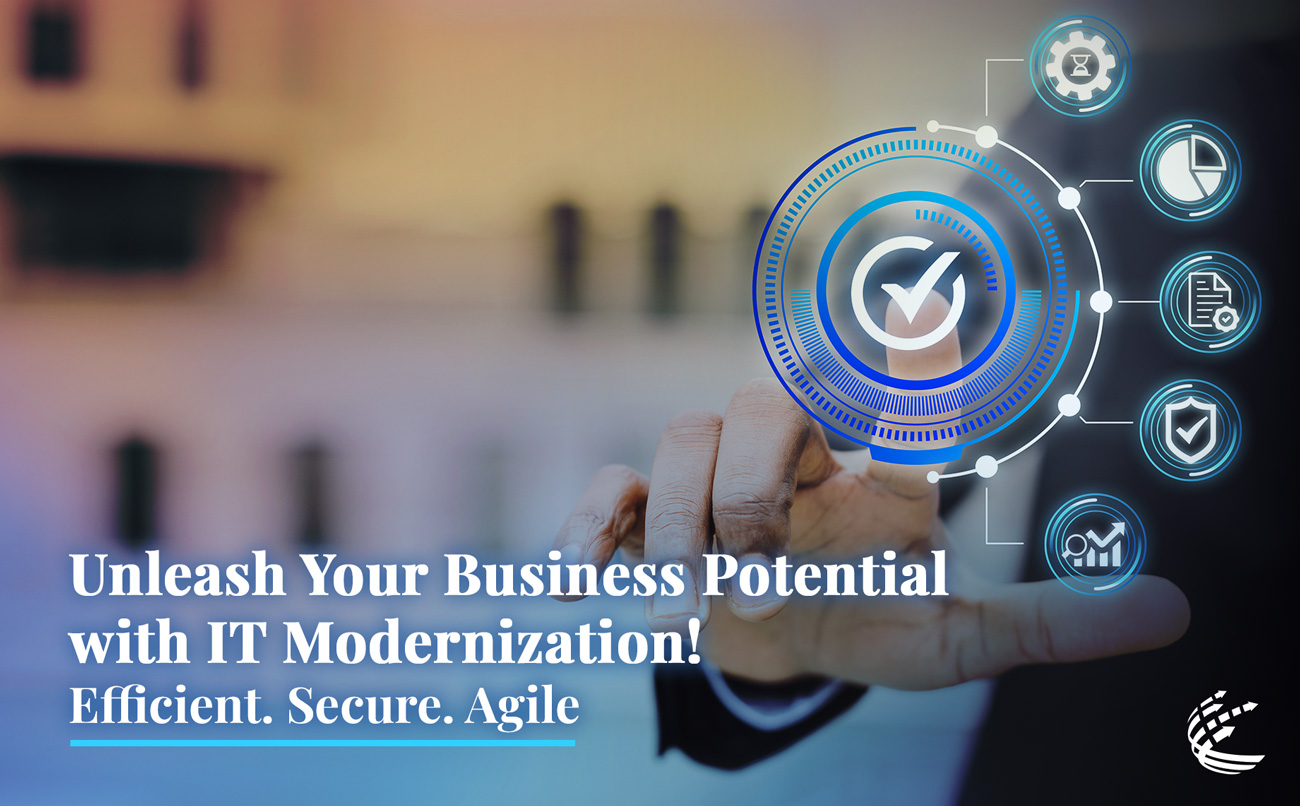
From Obsolete to Outstanding: Key Benefits of IT Modernization!

Today, IT modernization has emerged as a critical imperative for organizations seeking to stay competitive in the digital era. The rapid pace of technological advancements, coupled with changing business demands, has necessitated a paradigm shift in the way enterprises approach their IT infrastructure. In an age where information is a currency, the ability to harness the full potential of technology is a key differentiator for businesses. Legacy systems, once the backbone of many enterprises, often struggle to keep pace with the demands of modern business operations. Outdated hardware, software, and infrastructure can lead to inefficiencies, security vulnerabilities, and hinder agility. IT modernization, therefore, becomes crucial to overcome these hurdles and unlock new opportunities.
By embracing the latest technologies, organizations can streamline processes, enhance scalability, and position themselves for innovation. Whether it’s migrating to the cloud, adopting DevOps practices, or implementing cutting-edge applications, modernization efforts are integral to future-proofing an organization’s IT ecosystem. The essence of IT modernization lies in fortifying an organization’s technological foundation, ensuring IT becomes a strategic asset rather than a mere operational necessity. As businesses try keep pace with the escalating complexity and dynamicity of the digital age, this radical transformation becomes vital for being agile and competitive.
Before embarking on the modernization journey, organizations need to conduct a comprehensive assessment of their existing IT infrastructure. This includes an inventory of hardware, software, and applications, as well as an analysis of their interdependencies. Understanding the current state is crucial for devising a targeted modernization strategy. As all systems need not be modernized simultaneously, a roadmap needs to be devised. Organizations should prioritize their modernization efforts based on business impact, addressing the most critical aspects first. Developing a phased roadmap allows for a structured approach, minimizing disruptions and ensuring a smoother transition.
There are multifaceted advantages of IT modernization that extend far beyond the surface level. From operational efficiency to agility, from scalability to cost effectiveness, each facet of IT modernization plays a pivotal role in shaping a future ready business environment. The top 8 benefits of adopting IT modernization are as follows:
- Cybersecurity Fortification: As cyber threats become increasingly sophisticated, IT modernization takes center stage in fortifying an organization’s digital fortress. The implementation of robust cybersecurity measures, including advanced encryption protocols and real time threat detection, ensures the protection of sensitive data and maintains the trust of clients and stakeholders.
- Productivity Boost: Modernizing IT infrastructure streamlines processes, reduces bottlenecks, and enhances overall productivity. Cloud computing, automation and advanced analytics contribute to smoother workflows, allowing organizations to optimize resource utilization and empower employees to focus on strategic initiatives rather than mundane tasks.
- Improved Customer Experience: IT modernization directly impacts customer experience by enabling personalized services, quicker response times and seamless interactions. Modernized systems facilitate a deeper understanding of customer needs through data analytics, allowing organizations to tailor their offerings and communication strategies. This heightened responsiveness and customization contribute to elevated customer satisfaction and loyalty.
- Reduced Ops Cost & Tech Debt: While the initial investment in IT modernization may seem substantial, the long-term benefits are undeniable. Cost-effective modernization solutions eliminate the high maintenance and operational cost of legacy systems and avoid additional expenses that can be incurred towards security and scalability. Additionally, cloud-based solutions eliminate the need for large on-premises infrastructure resulting in further lowering the maintenance expenses.
- Enhanced collaboration: Modernized IT infrastructure fosters collaboration by breaking down silos and promoting seamless communication. Cloud-based collaboration tools, video conferencing and real-time document sharing enhance teamwork especially in a globalized and remote work environment. Improved collaboration accelerates project timelines and stimulates innovation through diverse perspectives and expertise.
- Reduced downtime: Modernized IT systems are inherently more robust and resilient, leading to a significant reduction in downtime. Advanced monitoring tools and predictive maintenance minimize the risk of system failures. This enhanced reliability ensures uninterrupted operations, contributing to increased productivity and customer satisfaction.
- Improved Business Agility: Modernized IT infrastructure enables organizations to proactively react to changing market dynamics faster. Cloud-based solutions and agile development practices empower teams to adapt to evolving business requirements, fostering a culture of innovation and responsiveness.
- Scalability: Traditional IT systems can be rigid sometimes. They often struggle to adapt to fluctuating workloads. A highly scalable and elastic IT infrastructure that can be scaled up and down as per the business requirement offers the much-needed flexibility and efficiency to the business operations. This results in increased agility and ensures resources are optimally utilized.
As organizations opt for IT Modernization, it is essential to view it not merely as a technological upgrade. IT modernization is a tailored approach that considers the unique needs and aspirations of each organization. The benefits, especially the enhanced agility, improved scalability, and cost optimization, position organizations to embrace future opportunities with confidence. And modernizing in the emerging tech areas of cloud, data analytics, AI, IoT & cybersecurity helps in staying at the forefront of digital transformation and innovation. By integrating these cutting-edge technologies, businesses can unlock unprecedented potential, paving the way for a more resilient and efficient future.
Source: Sales Team & Nasscom Report
Date: 21 November 2023
